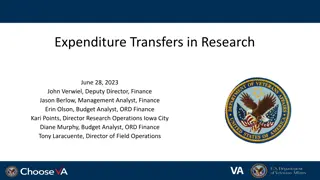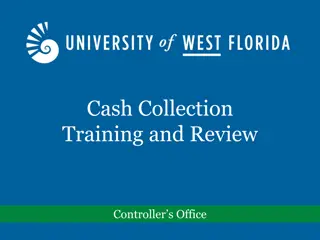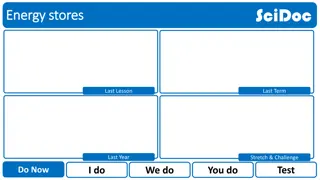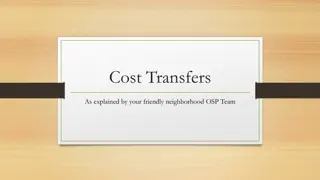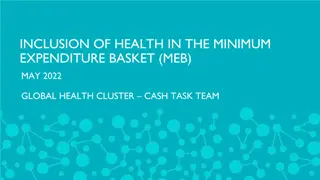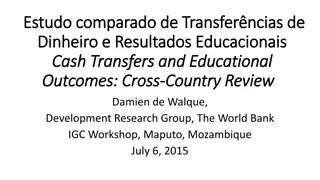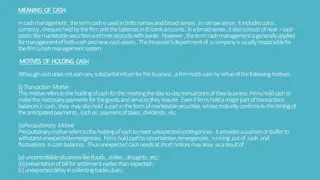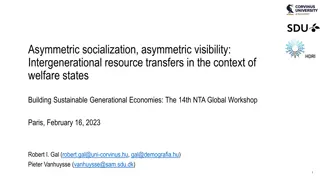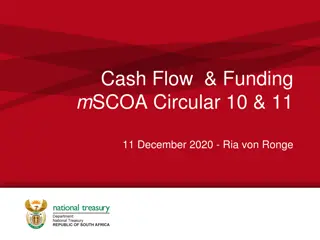Productive Impacts of Social Cash Transfers
This presentation discusses the potential of social cash transfers to enhance productivity by influencing consumption, investment decisions, and risk management strategies among poor households. It explores how transfers can be utilized for productive purposes, such as agricultural technology adoption and microenterprise promotion, to complement broader development agendas and break the cycle of poverty.
Download Presentation

Please find below an Image/Link to download the presentation.
The content on the website is provided AS IS for your information and personal use only. It may not be sold, licensed, or shared on other websites without obtaining consent from the author.If you encounter any issues during the download, it is possible that the publisher has removed the file from their server.
You are allowed to download the files provided on this website for personal or commercial use, subject to the condition that they are used lawfully. All files are the property of their respective owners.
The content on the website is provided AS IS for your information and personal use only. It may not be sold, licensed, or shared on other websites without obtaining consent from the author.
E N D
Presentation Transcript
From Protection to Production: The Productive Impacts of Social Cash Transfers Paul Winters Department of Economics, American University Building Resilience and Assets for Food Security: Evidence and Implications for Feed the Future presented by USAID and the Assets and Market Access CRSP September 29-30, 2011, Washington DC
Motivation for studies Objectives of Social Cash Transfers programs Social protection Reduce consumption poverty Induce investment in child health and education Break the intergenerational transmission of poverty
Motivation Criticism of SCTs Focus solely on long-term poverty reduction Weak link to productivity human capital, skills, labor market insertion Agriculture? Miss opportunities to complement broader development programs, particularly productive investment Investment in human capital to what end Intergenerational transmission of welfare receipt? Productive vs. social (unproductive?) investment
Motivation Productive cash transfers Can they be used for productive purposes as a complement to broader development agenda? Agricultural technology adoption Agricultural asset accumulation With land formalization projects Promoting microenterprises Under what conditions?
Social cash transfers and productive choices Transfers can influence consumption and production decisions when markets fail or are incomplete Transfers as a source of liquidity Credit constraints potentially limit productive spending and investment Transfers can induce spending and investment altering production and the allocation of resources, including labor
Social cash transfers and productive choices Transfers as a secure source of income Insurance and credit market imperfections limit the ability of poor households to smooth consumption Poor households take action to manage risk ex ante and cope with risk ex post Transfers provide regular income uncorrelated with other income sources, potentially altering risk management and coping strategies, and therefore production choices
Objective To look beyond the social protection function of SCT programs and analyze the impact of these programs on productive activities Mexico s Oportunidades Todd, J., Winters, P. and Hertz, T., 2010. Conditional Cash Transfers and Agricultural Production: Lessons from the Oportunidades Experience in Mexico. Journal of Development Studies 46(1), 39-67 Malawi Social Cash Transfer Program Covarrubias, K., Davis, B. and Winters, P., 2011. From Protection to Production: Productive Impacts of the Malawi Social Cash Transfer Scheme. Boone, R., Covarrubias, K., Davis, B. and Winters, P., 2011. The Impact of Social Cash Transfers on Agricultural Production: The Case of Malawi.
Mexican Oportunidades program Initiated in 1997 as PROGRESA in marginal rural areas (506 localities in 7 states) Targets poor using proxy means test Transfer primarily go to women Food/nutrition and education transfers conditioned on health and education behavior
Oportunidades: Data and method Random assignment of eligible communities to treatment and control (320 treatment 186 control) 9936 households 6281 treatment, 3655 control Baseline: 1997 census and March 1998 survey Follow-up: Oct 1998, March 1999 and Nov 1999 Questionnaire limited in production questions Own food production, land use, livestock, agricultural spending Different agricultural seasons
Consumption from own production Control mean 0.70 Control mean 0.68 May 1999 0.04** (0.023) Oct 1998 0.04** (0.035) HH consumes from own production Per capita value of own production 25.11 3.00*** (0.008) 23.61 0.97 (0.517) Number of food groups from own production 1.16 0.12*** (0.004) 1.13 0.12*** (0.011) Number of foods from own production 1.26 0.14*** (0.003) 1.17 0.14*** (0.004) P-values in parenthesis
Cons. own production: Food groups Control mean 0.52 Control mean 0.50 May 1999 0.03 (0.124) Oct 1998 0.02 (0.278) Cereals 0.06 0.02* (0.080) 0.06 0.00 (0.895) Beans 0.24 0.05** (0.024) 0.16 0.21 (0.282) Fruit 0.12 0.00 (0.964) 0.23 0.37** (0.031) Vegetables 0.07 0.02** (0.012) 0.01 (0.455) 0.05 0.01 (0.113) 0.01 (0.536) Meat 0.10 0.11 Eggs P-values in parenthesis
Agricultural investment and spending Control mean 0.59 Control mean 0.55 May 1999 0.23 (0.203) Oct 1998 0.34** (0.048) Use land Per capita hectares of land use 0.26 0.32* (0.094) 0.24 0.01 (0.378) 0.77 0.03* (0.060) 0.72 0.03** (0.037) Own livestock Per capita livestock ownership 0.14 0.02* (0.099) 0.14 0.03*** (0.007) 0.43 0.05** (0.013) 21.1 (0.478) 0.34 0.02 (0.321) 30.1 (0.403) Agricultural spending Per capita agricultural spending 210 181 P-values in parenthesis
Effects by land holdings Consumption from home production Landless & 0-3 hectares: similar to general effects >3 hectares: no effects Cons. from own productions by food groups Landless & 0-3 hectares: similar to general effects >3 hectares: effects on fruit in Oct Agricultural investment and spending Landless: Only land use effects and livestock on Oct 0-3 hectares: Land area effects, strong livestock effects (Oct and May) and agricultural spending in Oct >3 hectares: no effects
PROCAMPO and Oportunidades PROCAMPO Decoupled cash transfer provided to compensate (1993-1994) staple producers given expected impact of NAFTA 34% receive PROCAMPO 22% receive both Highly agriculturally oriented Impact of Oportunidades on PROCAMPO producers Impact on all households not just PROCAMPO But significantly larger impact of Oportunidades for PROCAMPO recipients on own food consumption (cereals), land use, livestock ownership, agricultural spending
Malawi Social Cash Transfers Initiated in 2006 with intention to reach poorest 10% of population Expanding with hope of reaching 300,000 households by 2015 Targets ultra poor, labor constrained households geographic combined with community targeting within Village Development Groups (VDGs) Unconditional cash transfer but encouraged to invest in children (soft conditions)
Malawi SCT: Data and method Evaluation 2007-2008 Random assignment of eight VDGs into treatment and control in Mchinji district 751 households 386 treatment, 365 control Baseline: March 2007 Follow-up: Sept 2007 and April 2008 Questionnaire limited in production questions Agricultural assets, some time use, own production
Agricultural assets (preliminary) Male head 0.02 (0.755) Female head 0.19*** (0.000) Total 0.13*** (0.000) Labor>0 0.10** (0.044) Labor=0 0.16*** (0.007) Hoes 0.29*** (0.000) 0.23*** (0.000) 0.34*** (0.000) 0.19*** (0.000) 0.34*** (0.000) Sickles 0.48*** (0.000) 0.58*** (0.000) 0.41*** (0.000) 0.43*** (0.000) 0.52*** (0.000) Goats Chicken 0.59*** (0.000) 0.70*** (0.000) 0.50*** (0.000) 0.58*** (0.000) 0.60*** (0.000) P-values in parenthesis
Time use (preliminary) Sept 07 -0.01 (0.400) April 08 0.12*** (0.000) Own farm -0.33*** (0.000) -0.44*** (0.000) Casual labor -2.32*** (0.000) -3.00*** (0.000) Casual labor days 0.14*** (0.000) 0.14*** (0.000) Household work P-values in parenthesis
Source of food: Sept / Apr (preliminary) Own Production + / + Purchase + / + Gift - / - Cereals Tubers + / + + / + - / - Pulses + / + + / + 0 / 0 Vegetables + / + + / + - / - Animal products + / + + / + 0 / 0 Fruits + / + + / + 0 / 0 Regular maize flour + / 0 + / + - / - Fine maize flour + / + + / + - / -
Conclusions SCTs, while linked to long-term human capital investment, have an impact on productive decisions Crop/food diversification, agricultural spending, time use, land use, investment Impacts are evident among land poor (Oportunidades) and poor/labor constrained (Malawi) Impact possible linked to credit and insurance market imperfection
Conclusions Impacts appear greater for those with agricultural potential (PROCAMPO) Targeting agricultural households may induce greater productive impacts Suggests possibility of using productive cash transfers Under what conditions? Need for further analysis FAO/UNICEF funded by DFID From Protection to Production
New CTs in SSA accompanied by rigorous impact evaluation Ethiopia PNSP, 2006-2010 Regional minimum social protection package, 2011- 2013 Ghana LEAP Pilot, 2010-2012 Lesotho CGP Pilot, 2011-2012 Uganda, begins in 2011 Zimbabwe, begins in 2011 Tanzania, TASAF Malawi SCT Mchinji pilot, 2007-2009 Expansion, 2011-2013 Kenya CT-OVC Pilot 2007-2011 Expansion, 2011-2013 Mozambique PSA Expansion, 2008-2009 Zambia Kalombo pilot, 2005 Monze pilot, 2007-2010 Expansion and child grant, 2010-2013 South Africa CSG Retrospective and expansion, 2010-2013
FAO/UNICEF funded by DFID From Protection to Production Countries and programs Formally: 1) Lesotho Child Grant Program (baseline 2011, follow up 2012) 2) Ethiopia Tigray SP package (baseline 2011, follow up 2012) 3) Malawi SCT expansion (baseline 2011, follow up 2012) 4) Kenya CT-OVC (2nd follow up 2011) 5) Ghana LEAP (follow up 2012) 6) Zimbabwe SCT (baseline 2012, follow up 2013) Informally: 1) Zambia SCT (baseline 2010, follow up 2012) 2) South Africa CSG (retrospective, 2010)
Strengthen data collection and analysis Design, pilot and supervise implementation of additional modules in household surveys Analyze household economic decision making on productive activities and labor allocation; climate change adaptation; risk coping; time use and social networks using baseline and follow up data---disaggregated by gender Economic linkages questions throughout household questionnaire, as well as business enterprise survey Simulate local economy impacts using village SAM/CGE models Integrate qualitative/quantitative design and methods Lead a research network on impact evaluation of CT programs in SSA










